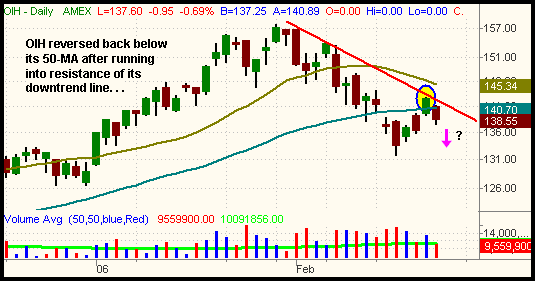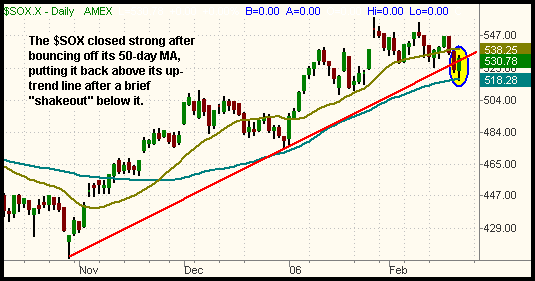Buy the semis, but avoid this ETF
Stocks followed-up two days of lower
volume losses with a solid session of broad-based gains on expanding volume
yesterday. The Nasdaq Composite
(
COMP |
Quote |
Chart |
News |
PowerRating) rebounded 0.9%, wiping
out the previous day’s loss and enabling the index to close where it began the
week. Both the small-cap Russell 2000
(
RUT |
Quote |
Chart |
News |
PowerRating) and mid-cap S&P 400 indices also
advanced 0.9%, while the S&P 500
(
SPX |
Quote |
Chart |
News |
PowerRating) similarly gained 0.8%. Contrary to
recent action, the Dow Jones Industrials lagged a bit, but its 0.6% gain was
still enough for the blue chip index to close at a new high. As anticipated, new
support of its prior downtrend line helped the S&P to bounce yesterday, while
the Dow’s support of its prior high did the same for that index.
Total volume was 5% higher than the previous day’s level in
both exchanges, causing both the S&P and Nasdaq to register a bullish
“accumulation day.” However, despite the rise in turnover, volume in both the
NYSE and Nasdaq still came in below the respective 50-day average levels. While
it was certainly positive that higher volume confirmed yesterday’s gains, the
modest expansion in turnover indicates many institutional players still remained
on the sidelines. In the Nasdaq, for example, volume has come in above its
50-day average level in only two of the past seven sessions. Yesterday was not
one of them Although it is only February, recent volume levels have been more
typical of the annual summer doldrums.
Market internals were positive yesterday, though not by an
overly wide margin. In the Nasdaq, advancing volume exceeded declining volume by
only 3 to 2. The NYSE ratio was positive by just less than 2 to 1. Generally
speaking, we like to see advancing volume exceed expanding volume by at least 2
to 1 in order to confirm an “up” day. In fact, it’s not uncommon for the ratio
to be positive by more than 4 to 1 on strong “accumulation days.” This ratio is
important because it tells us how much volume is behind the stocks that were
gaining or declining. We feel it gives a more accurate view of what is happening
“beneath the surface” than merely following the number of issues advancing or
declining (standard market breadth).
Among yesterday’s top sectors, the PowerShares Halter China
Index ($HXC) rallied 1.7% and closed at a new all-time high. Our long position
in FXI (iShares Xinhua China 25 Fund) surged 2.1% to a new high as well. The
Biotech Index
(
BTK |
Quote |
Chart |
News |
PowerRating), which we pointed out to subscribers on February 17,
also showed a lot of relative strength and gained 1.9% yesterday. The index
again closed at a new 5-year high.
We once again saw an inverse relationship between
transportation and oil-related stocks yesterday. The DJ Transportation Average
gained 1.2% and finished at a fresh record high, but the Oil Service Index
(
OSX |
Quote |
Chart |
News |
PowerRating)
fell 2.3%. The $OSX also closed back below its 50-day moving average after
recovering above it for only one day. Since the start of the month, the $OSX has
been in a steady downtrend and resistance of that downtrend line is what stopped
the February 21 advance. OIH (Oil Service HOLDR) closed yesterday near the price
we covered that short position for a 10-point gain back on February 10. However,
you may consider re-shorting OIH in anticipation of the downtrend’s resumption.
If shorting OIH near its current level, a stop at least one point over the
February 21 high is ideal. The daily chart of OIH below illustrates resistance
of its current downtrend line:

On the flip side, we like how the Semiconductor Index
(
SOX |
Quote |
Chart |
News |
PowerRating)
bounced off support of its 50-day moving average yesterday. As we mentioned last
week, the daily chart of the $SOX is choppy, but the uptrend line from the low
of October 2005 remains intact. The chart below illustrates yesterday’s bounce
off the 50-day MA, as well as support of the primary uptrend line:

We feel the Semiconductor Index now provides low-risk entry
points on the long side, BUT the one big concern is that the Nasdaq remains
below its primary downtrend line. Nevertheless, buying one of the Semiconductor
ETFs at current levels presents a positive risk/reward ratio because you can
simply place your stop below yesterday’s low. The downside risk would therefore
be minimal, while the potential profit is large, particularly if the primary
uptrend resumes. Of the three main semiconductor ETFs (SMH, IGW, and PSI), we
would recommend avoiding SMH due to its relative weakness that is caused by too
heavy a concentration in Intel. Both IGW and PSI, on the other hand, are
consolidating nicely. Regular subscribers will see our trigger, stop, and target
prices on IGW below.
Open ETF positions:
Long FXI, short MDY (regular subscribers to
The Wagner Daily
receive detailed stop and target prices on open positions and detailed setup
information on new ETF trade entry prices. Intraday e-mail alerts are also sent
as needed.)
Deron Wagner is the head trader of Morpheus Capital Hedge Fund and founder of
Morpheus Trading Group (morpheustrading.com),
which he launched in 2001. Wagner appears on his best-selling video, Sector
Trading Strategies (Marketplace Books, June 2002), and is co-author of both The
Long-Term Day Trader (Career Press, April 2000) and The After-Hours Trader
(McGraw Hill, August 2000). Past television appearances include CNBC, ABC, and
Yahoo! FinanceVision. He is also a frequent guest speaker at various trading and
financial conferences around the world. For a free trial to the full version of
The Wagner Daily or to learn about Deron’s other services, visit
morpheustrading.com or send an e-mail to
deron@morpheustrading.com .
Â
